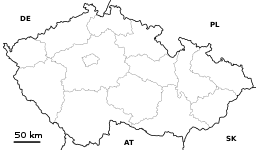Olešnice (Blansko District)
| Olešnice | |||
| Town | |||
View on Olešnice | |||
|
|||
| Country | Czech Republic | ||
|---|---|---|---|
| Region | South Moravian | ||
| District | Blansko | ||
| Commune | Boskovice | ||
| Rivers | Hodonínka, Veselský Potok | ||
| Elevation | 540 m (1,772 ft) | ||
| Coordinates | 49°33′N 16°25′E / 49.550°N 16.417°ECoordinates: 49°33′N 16°25′E / 49.550°N 16.417°E | ||
| Area | 12.52 km2 (4.83 sq mi) | ||
| Population | 1,722 (2012) | ||
| Density | 138/km2 (357/sq mi) | ||
| Mayor | Zdeněk Peša | ||
| Timezone | CET (UTC+1) | ||
| - summer (DST) | CEST (UTC+2) | ||
| Postal code | 679 74 | ||
  Location in the Czech Republic | |||
| Wikimedia Commons: Olešnice | |||
| Statistics: statnisprava.cz | |||
| Website: www.olesnice.cz | |||
Olešnice (also known as 'Olešnice na Moravě' or Oels in German) is a town in the South Moravian Region in the Czech Republic. It has approximately 1,700 inhabitants.
Olešnice probably originated in the 11th century but the first written record of Olešnice dates back to 1073, while the first official record is from 1348. During the colonization of the Bohemian border regions in the mid-13th century, German colonists built settlement German Oels on the east bank opposite the village Olešnice (in the area of today's marketplace). The part of the village on the Moravian side was called Moravian Olešnice while the German part was called German Olešnice. German Olešnice developed into a market town, and gt township status in 1360's. In 1442 Olešnice fell to the Hussites and was plundered. Olešnice was firstly part of the dominion Louka and was owned by the Lords of Lomnice. Until 1496 the township was property of the Nobility from Pernštejn, later it belonged to Kunštát dominion and between 1678 and 1733 to the Nobility from Lamberk. During the Thirty Years War the township suffered heavy damage and 800 inhabitants left the devastated site. Even though the new owners tried to repopulate the township, 24 from 123 were still deserted in 1674. Until 1759, the municipal property was managed separately by the German and Moravian part of the township. In 1759 both parts made an agreement about joint management of the municipal property. In 1799, the Meat Market at the St. Lawrence Church was converted into a school building. In the beginning of the 19th century Olešnice suffered from several fires whereof the most devastating was the 1827 fire. This fire destroyed Lawrence of Rome Church from the 15th century. In 1850 an artificial flowers production started in the town. A cloth weaver manufacture was established in the mid 18th century and from 1816 blueprint started in Danzinger family. Olešnice has been using flag since 1997 and in December 1999 it acquired status of town. Town's coat of arms is related to coat of arms of Nobility from Lomnice.
Among the most important people born in Olešnice belong historian Augustin Neumann (1891-1948), architect Vladimír Dufka (1892–1969), historian and poet Karel Doskočil (1908-1962) and musicologist Jaroslav Pohanka (1924-1964).
Places of interest
- The townhall, originally from 1794, rebuilt after 1980
- 19th century Lawrence of Rome Church
- Statue of Wenceslaus I in the town square
- Saint Nicholas Church from 1725, rebuilt in 1882
- Fortress Cvrhov
- Lamberk chateau built in 18th century
- Ruins of castle Louka
Gallery
-kostel-na-n%C3%A1m%C4%9Bst%C3%AD2013d.jpg) St. Laurentius
St. Laurentius- Chateau Lamberk
-k%C5%99%C3%AD%C5%BE-na-n%C3%A1m%C4%9Bst%C3%AD2013.jpg) Town square
Town square- The Church of Evangelical Church of Czech Brethren
- Saint Nicholas Church
External links
| Wikimedia Commons has media related to Olešnice (Blansko District). |

